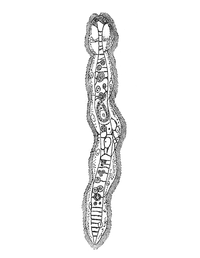The Rhombozoa, or Dicyemida, are a group of tiny parasites that live in the renal appendages of cephalopods.
| Rhombozoa/Dicyemida | |
|---|---|

| |
| Scientific classification | |
| Kingdom: | |
| Superphylum: | |
| Phylum: | Rhombozoa van Beneden, 1876
|
| Families | |
Classification is controversial.[1] They are probably a new phylum. Traditionally, dicyemids have been grouped with the Orthonectida in the Mesozoa. However, molecular phylogeny indicates that dicyemids may be more closely related to the roundworms.[2]
Anatomy
changeAdult dicyemids range in length from 0.5 to 7 millimetres (0.020 to 0.276 in), and they can be seen through a light microscope.[3] They have eutely: each adult individual of a given species has the same number of cells. Cell number is a useful identifying character.
The organism's structure is simple: a single axial cell is surrounded by a jacket of twenty to thirty ciliated cells.[3]
Life cycle
changeDicyemids exist in both asexual and sexual forms. The asexual forms are found in juvenile and immature hosts; and the sexual forms in mature hosts.
The asexual stage is termed a nematogen; it produces vermiform (worm-like) larvae in the axial cell. These mature through direct development to form more nematogens.[3] Nematogens proliferate in young cephalopods, filling the kidneys. Later, as the hosts mature, sexual forms called rhombogens are formed. They are hermaphrodites, with gonads of both sexes. The rhombogens self-fertilise, and later release larvae.
References
change- ↑ Aruga J, Odaka YS, Kamiya A, Furuya H (2007). "Dicyema Pax6 and Zic: tool-kit genes in a highly simplified bilaterian". BMC Evol. Biol. 7: 201. doi:10.1186/1471-2148-7-201. PMC 2222250. PMID 17961212.
{{cite journal}}: CS1 maint: multiple names: authors list (link) - ↑ Pawlowski J, Montoya-Burgos JI, Fahrni JF, Wüest J, Zaninetti L (October 1996). "Origin of the Mesozoa inferred from 18S rRNA gene sequences". Mol. Biol. Evol. 13 (8): 1128–32. doi:10.1093/oxfordjournals.molbev.a025675. PMID 8865666.
{{cite journal}}: CS1 maint: multiple names: authors list (link) - ↑ 3.0 3.1 3.2 Barnes, Robert D. (1982). Invertebrate Zoology. Philadelphia, PA: Holt-Saunders International. pp. 248–249. ISBN 0-03-056747-5.